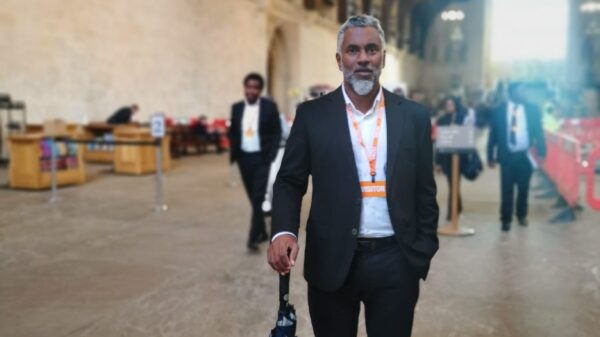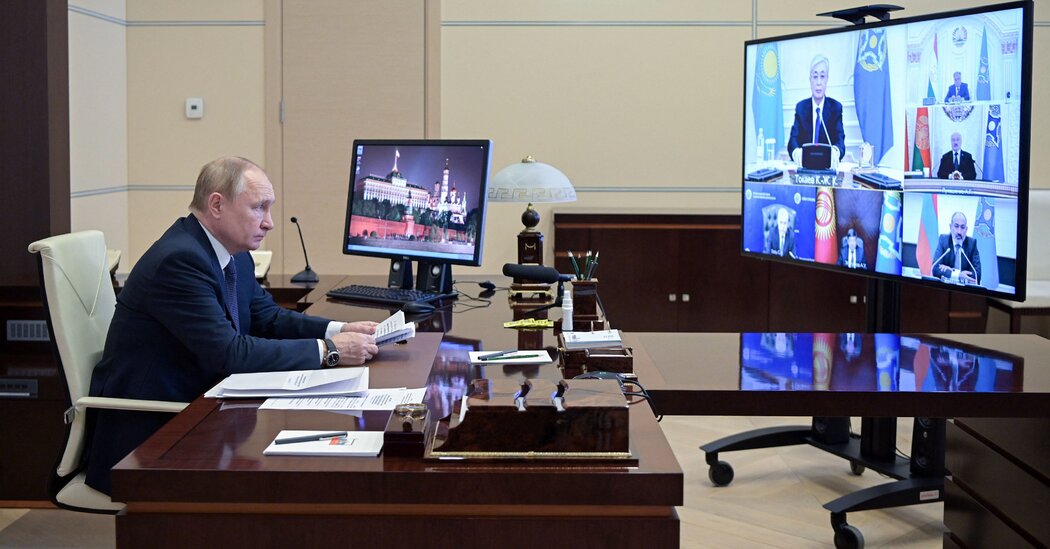The Russian leader is fighting fires on multiple fronts, illustrating the danger of his strategy of relying on force to aid his autocratic neighbors.
From Eastern Europe to the oil fields of Central Asia, President Vladimir V. Putin is straining to maintain a sphere of influence that will keep the forces of history at bay.
The Russian leader’s allies, perched atop former Soviet republics, are growing old in office or face rising discontent. The bulwarks they have provided against the expanding frontiers of democracy and Western military power look increasingly shaky.
So Mr. Putin is relying more on brute force to hold it all together: preparing a possible invasion of Ukraine to keep it out of NATO, sending troops to Kazakhstan to suppress protests and threatening to do the same in Belarus.
Coercing allies is hardly unusual for great or regional powers. The Soviet Union, whose loss Mr. Putin often laments, sent tanks into Hungary, Czechoslovakia and Afghanistan. Still, it bonded its empire through Communism, which instilled a common mission and a sense of existential conflict with the capitalist West.
Now, with capitalism and at least pretensions of democracy the norm on both sides of the old Iron Curtain, there is little to justify fealty to Moscow beyond the shared desire of post-Soviet strongmen to help one another cling to office.
“There’s no real ideological glue to hold together this motley alliance of people with very different interests,” said Timothy M. Frye, a Columbia University political scientist.
Mr. Putin’s sphere of influence, for all the trouble it causes the West, is increasingly a cage of his own making. The more that he relies on force to prop up aging, unpopular autocrats on his periphery, the more besieged his alliance becomes, both by dissent at home and Western pressure abroad.
As a result, the very threats that Mr. Putin hoped to avert are instead growing. Ukraine is rushing into the West’s arms. Provocations by Belarus, rooted in its crackdown on rising dissent, are uniting Europe against its pro-Moscow leader. And protesters in long-stable Kazakhstan are demanding change.
Mr. Putin has sought to turn his reactive escalations into a strength at home, portraying his interventions into those countries’ problems as reclaiming Soviet greatness.
But a tepid public reaction, as well as the Kremlin’s recent crackdowns on civil society and political rivals, Dr. Frye said, indicated that “the usual narratives that Putin has used to shore up his rule are just not working as well.”
Imposing Loyalty
Mr. Putin’s fear of democratic encroachment is often traced to the so-called color revolution democratic uprisings that swept several former Soviet republics in the 2000s. He and his deputies still speak often of those events, usually as Western plots to subvert Russian power.
But Mr. Putin’s response did not crystallize until 2012, when he cracked down violently on protests against him in Russia. Many of the demonstrators belonged to the Russian middle class that had once widely backed him. This elevated hard-liners within his administration, while also leading Mr. Putin to shift his power base to security services.
The Kremlin, increasingly hawkish and nationalistic, even paranoid, settled on a strategy of propping up neighboring leaders who would control dissent and oppose the West.
As a result, Mr. Putin came to believe that only leaders who look like him — autocratic strongmen — could be trusted to keep the dangers of democracy and Western influence at bay.
Any others would have to be forced into loyalty.
After Ukrainian protesters ejected their country’s pro-Moscow president in 2014, Mr. Putin did not seek to persuade newly empowered Ukrainian voters to align with Moscow. Rather, hoping to strong-arm Ukrainian leaders into obedience, Russia invaded and annexed one part of Ukraine and sponsored separatists in another.
So far, this strategy has largely backfired. Western powers increased their support for Ukraine, and Ukrainian voters, once divided over relations with Russia, turned sharply against it. But Mr. Putin, perhaps unable to see a neighboring democracy as anything other than a threat, has only escalated his efforts, and is now threatening a major invasion of Ukraine.
This may well forestall overt alignment between Ukraine and the West, or even force Washington to redouble its acknowledgment of Russian interests there. But one danger for Mr. Putin is that it may not work forever and, once failed, could see yet another former Soviet republic join the European institutions that he insists are a threat to him.
A Shrinking Circle
Mr. Putin’s reliance on fellow strongmen has proved nearly as risky.
Strongman-ruled countries, which concentrate power in one person’s hands at the expense of governing institutions, tend to be more unstable, more corrupt and less economically effective, all of which deepen public dissatisfaction.
The dangers of this can be seen in Kazakhstan, where a carefully planned transition from one leader to the next broke down into violent unrest.
Understand the Protests in Kazakhstan
What’s happening? Protests in Kazakhstan incited by anger over surging fuel prices have intensified into deadly clashes over the future direction of the autocratic Central Asian country. Here’s what to know about how the protests started and why they matter:
Mr. Putin sent a Russian-led force of 2,500 troops to Kazakhstan to help put down the turmoil, at a time when tensions with Ukraine and Belarus were already simmering. It has been an illustration of the perilous bargain holding Mr. Putin and his allies together, in which they are essentially obligated to guarantee one another’s rule by force.
Strongman leaders are also likelier to start conflicts and likelier to lose them, Erica Frantz, a Michigan State University scholar of authoritarianism, said she has found in her research.
“Personalists don’t have to bargain over policy, and lack of accountability leads to riskier behavior,” she said, using a formal term for such leaders.
While their fear of democracy makes them useful allies to Mr. Putin, the downsides of their rule increasingly bedevil his informal alliance.
“Provocations are what we would expect. We’d also expect some of his moves to be bad choices,” Dr. Frantz said.
Even with democracy’s global travails, it has nonetheless remained widely accepted since the Cold War’s end, beyond a handful of countries like China or Cuba, as the default, forcing even unabashed dictators to at least pretend at democracy.
The result is a circle of pro-Moscow strongmen who frequently struggle to persuade their citizens why it is necessary to accept fewer freedoms than those in neighboring countries.
Belarus exemplifies the dangers. Last year, as dissent rose over the government’s failures to address the pandemic, the president’s escalating crackdowns became a source of diplomatic conflict with the rest of Europe, which ensnared Mr. Putin.
Some Belarusian opposition activists, aware of Russia’s influence, signaled their openness to working with Moscow. But, in what may be a reflection of the Kremlin’s narrow insistence on familiar autocrats, for all their missteps, it has ignored their outreach.
Much as with Ukraine, Mr. Putin is left with a strategy in Belarus or Kazakhstan of ever-escalating coercion, albeit conducted through his allies in office.
These cycles, of shoring up a sphere of influence built on distrust and intimidation, can take on a logic of their own. So the strategy is pursued even when it appears likely to produce the opposite of Mr. Putin’s hoped-for results: both inviting the very threats he fears and eroding the alliance on which he has rested so much of his future.
“It will certainly produce more militarization of the alliance’s eastern flank,” Emma Ashford, a researcher at the Atlantic Council research group wrote of NATO’s likely response to Russia’s threats against Ukraine. “Just because we think it’s a stupid, self-defeating move on the part of Russia doesn’t mean they won’t do it.”

























